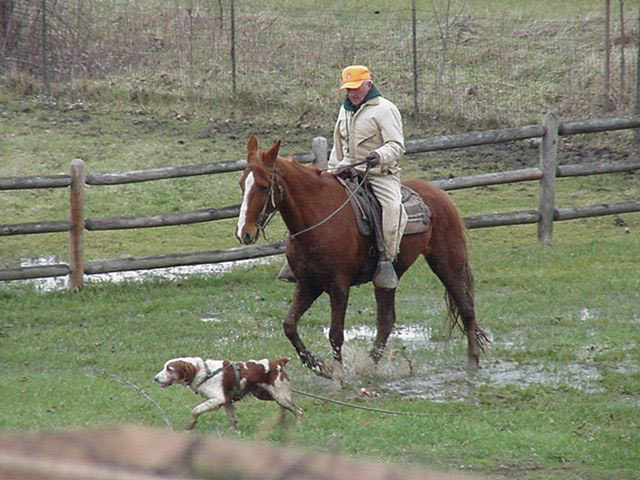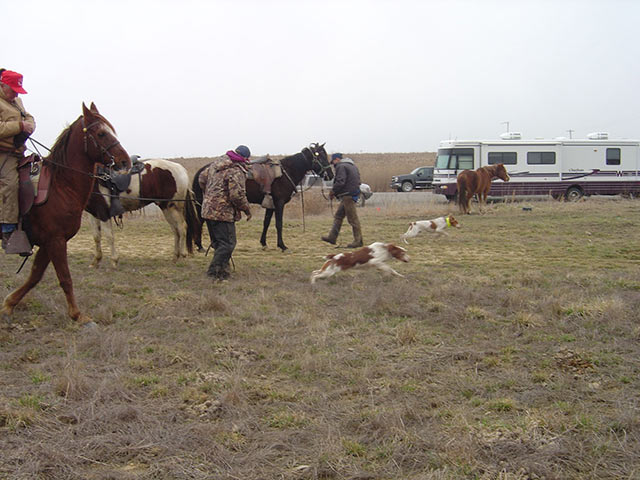50 Dog Years


Sitting at a poker table in 1952, a man got in over his head against the deputy sheriff. With nothing left, he wagered his dog. He lost the next hand, and the deputy sheriff became the owner of a young Brittany. The sheriff placed an ad in the paper, and Ray Trimble bought her. "She was a real nice little Brittany," Trimble says. Indeed, that first Brittany, obtained by chance, inspired a lifetime of dedication to Brittanys and the sport of field trials. Trimble, now 78, recounts more than 50 years of dogs, dog people, and dog events.
Growing up on a farm in Illinois, Trimble was interested in pheasant hunting from a young age. But the dogs he hunted with "were half purebreed and half whatever jumped the fence." It all changed after he obtained that Brittany. Over the next several years, he competed in many field trials. In 1963 he won his first championship.
Today, Trimble either runs his own Brittanys or judges other birding breeds throughout the Midwest every weekend. Field trials, Trimble explains, are attractive because they are all about having dogs do the field work they were bred to do, while also maintaining AKC breed standards. "My dogs would do very well in the show ring, if I ever wanted a dual championship," he says.
For Marianne Nixon, her love for purebred dogs began in the early 1950s, the result of a deal with her husband. "He was traveling for his job to Cuba and Mexico," she explains. She wanted to go with him, but was unable to. "I agreed to stay home, but I would get a new dog. That's how I got my first Lhasa Apso." Although a physical injury now prevents her from showing or judging, Ms. Nixon, with her daughter, finished more than 150 champion dogs. After she stopped showing, Ms. Nixon, now 75, became deeply involved in club-related activities for Lhasa Apsos, as well as Shih Tzus, Bichon Frises, Schipperkes, and Maltese. A graphics designer by profession, and one of the more computer-savvy members of her breed club, Ms. Nixon is often called upon to create training and seminar materials. But Ms. Nixon says that her most exciting project right now is a judges' guide for Lhasa Apsos, something that she says "expresses a love of the breed, and the way it is judged." The guide, nearly completed, provides thorough details of the Lhasa Apso standard.
Romance can be unpredictable in the universe of purebred dogs. Dorothy Nickles is 94, and she has been showing and judging in the ring for about 60 years. It began in 1935, when she was 25 years old and met a man with a boxer. "They say you have to go through a man's stomach to get to his heart. Well, I went through his dog." She got her first boxer, and made a favorable impression by turning that dog into a champion. Ms. Nickles then got a Standard Poodle, which she also made a champion.
At first, Ms. Nickles says, she had no intention of becoming a judge. But one day, after showing her dog, a judge suggested she get her license. "I told him, 'I'm a teacher. I don't have time.'" But she did give it a try and earned her first judging qualifications. Soon, one breed was not enough. "When you go to the shows, you see all the other dogs, and you want to do more." She continued to show and judge, and learned about every breed she saw. Recently, Ms. Nickles was the best-in-show judge at the Eukanuba match in Houston, appearing on Animal Planet. She also judged the well-respected AKC show in Orlando. "That was a high point of my life," she says. "With all the great judges, I was honored to be asked to do that show." Not ready to stop, Ms. Nickles names several shows she looks forward to judging in the coming years.
Wendell Sammett has been involved in the fancy for over 50 years. For the first 25, he bred both Dalmatians and Standard Poodles, but has been exclusively breeding Standard Poodles for the past 25 years. Now, at age 79, Sammett says that show-ring winning is not very important to him. This may sound odd coming from someone whose dog has captured best in show at Westminster more than once, but Sammett says that what keeps him excited is the possibility of impressing people who want great pets. In each litter, he explains, there may be one potential champion. "Too many people try to make the whole litter into champions. To me, there can only be one. All the others should become pets." When Sammett enters the ring now, his goal is "to show people how beautiful my dogs are. If I win, that's fine too. But it doesn't make my dogs any more or less valuable."
There is an emotional force that keeps fanciers going. As Dorothy Nickles says, "I could be feeling depressed. Then the first dog comes by in the ring and I feel good. It just does something to me." Watching the dogs prance around, Nickles says she has positive feelings about all of them. "You want to know what my favorite breed is?" she asks. "It's the one I am watching at that particular time." Her warmth extends to the people as well. "The school teacher in me just pops out. If someone does something wrong, I just tell them, 'let's try that again.' I don't mind doing that because it makes all the difference." This attitude draws Nickles closer to the animals, and makes exhibitors respect her. "Ask anyone who knows me, and they'll say that I don't just judge them, I try to help them."
For Ray Trimble, there is a congeniality at field trials that thrills him. "We all get along well together," he says. Even more impressive to Trimble is the way fellow competitors offer praise and support for each other, even when they lose. "It pleases you when someone comes up and says, 'Hey, that old dog of yours sure did a great job last week.' That keeps me going."
Fanciers are curious people. They want to learn more about the dogs, no matter how long they have been showing or judging. For Trimble, learning takes place in his interactions with other dog owners. "All you have to do is listen to people, and you'll be surprised how much you'll pick up from them." Walter Sammett says that the possibilities of genetics is also an exciting area of inquiry. "With breeding, there's a lot of mystery," he says. "It may seem one way on paper, but a lot of times it doesn't turn out that way." Sammett says that with all the new genetics knowledge, "You have to think far ahead about who you're going to breed this dog to, and what will happen with this next litter."
Ms. Nickles says that she has always seen judging as a way to learn. "Whenever I go to a show, something always comes up that I can store away." To this day, Ms. Nickles stays at dog shows from start to finish. "I want to compare my dogs to their dogs," she says, explaining that exhibitors never know when they may go up against that winning dog another time. If you are a judge, she says, watching the entire show offers insight about a specific dog or even an entire breed. Robert Smith, who is now 70 and has been judging since 1970, says that this kind of learning is both for the breeder and for the dogs. "Your objective must always be to breed better dogs," he says, and all new breeders must ask if they are truly interested in this goal. If so, it means taking the time to study the breed standards and observe as much as possible.
Long-time fanciers have some advice for those who represent the future of the sport. Dorothy Nickles says that young people should be patient and not expect too much in a short time. Speaking about judges, she says novices should begin with one or two breeds and stick with those for a while. "If you move too fast, you won't really know the breeds, and you won't establish a reputation." She complains that too many new judges want to become experts on a whole group right away. "There is not anybody smart enough to take on a whole group and know all the standards for all the dogs in that group when they've only been judging for a few years."
Ms. Nickles says that exhibitors also need patience. They should not expect to have a champion in their first litter. Speaking of moving up the ladder patiently, Wendell Sammett says that younger breeders often do not want to start with the basics. "People don't want to come into a kennel and pick up runs, do the basic stuff we all started out with. They want to go in and start showing right away." According to Robert Smith, this kind of impatience prompts too many people to view being a judge as a natural goal. "We're licensing judges too quickly," he says. "Not everyone needs to be a judge. Exhibitors are important, too. We wouldn't have a sport if it were not for exhibitors." Being impatient to finish a champion, or quickly become a judge, Mr. Smith says, "shows a demand for instant gratification, just like in society in general. We need to take the time to learn what it is all about."
Fanciers who have devoted their lives to purebred dogs never want to quit. "I'll stay with it as long as I am physically able to get on a horse," Trimble says, looking forward to many more weekends judging and running in the field with his Brittanys. Marianne Nixon says that it would be impossible for her to quit now, since the fancy is her whole social and emotional circle. "As the years went by, I was spending so much time at dog shows, one day I realized that all my friends are dog people."
Approaching her 95th birthday, Dorothy Nickles says her mind remains as sharp as ever. Just to make sure, though, she sometimes checks in with fellow judges. "I tell them, 'When you see that I'm faltering, you let me know.'" She laughs and adds, "But they keep telling me to stay right in there, I'm doing fine."
